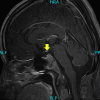Pituitary stalk interruption syndrome presenting in a euthyroid adult with short stature
- PMID: 29904499
- PMCID: PMC5999867
- DOI: 10.1016/j.radcr.2017.12.002
Pituitary stalk interruption syndrome presenting in a euthyroid adult with short stature
Abstract
Pituitary stalk interruption syndrome (PSIS) is a distinct and rare clinical entity responsible for congenital hypopituitarism resulting in deficiency of pituitary hormones with deficiency of the growth hormone (100%) and gonadotropins (97.2%) being its most common presentation at the time of hospital encounter (Wang et al., 2015). Isolated sparing of thyroid-stimulating hormone (TSH) with deficiency of the remaining anterior pituitary hormones may be present in PSIS, as is true in our case. Therefore, it should be kept in mind at the time of examination in suspected cases of PSIS.
Keywords: MRI.
Figures



References
-
- El Chehadeh-Djebbar S., Callier P., Masurel-Paulet A. 17q21.31 microdeletion in a patient with pituitary stalk interruption syndrome. Eur J Med Genet. 2011;54(3):369–373. - PubMed
-
- Fujisawa I., Kikuchi K., Nishimura K. Transection of the pituitary stalk: development of an ectopic posterior lobe assessed with MR imaging. Radiology. 1987;165(2):487–489. - PubMed
-
- Wang W., Wang S., Jiang Y., Yan F., Su T., Zhou W. Relationship between pituitary stalk (PS) visibility and the severity of hormone deficiencies: PS interruption syndrome revisited. Clin Endocrinol (Oxf) 2015;83(3):369–376. - PubMed
Publication types
LinkOut - more resources
Full Text Sources
Other Literature Sources

